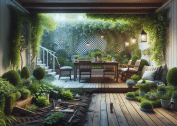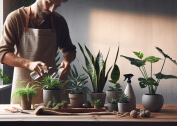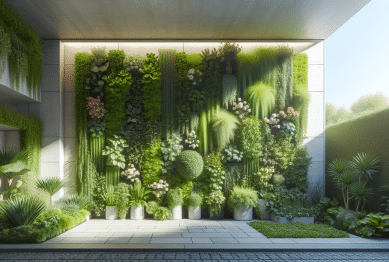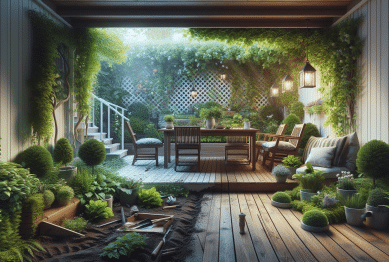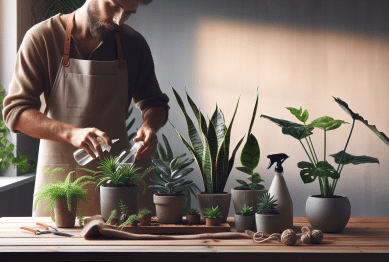Unlock the secrets to growing lush indoor plants with practical techniques and smart choices for every home. Learn how plant selection, light, soil, and easy care can transform any space into a green sanctuary. This guide walks through true essentials and inspiring ideas for happier, healthier indoor greenery.
Creating the Right Environment for Indoor Plants
Choosing the ideal environment is a make-or-break factor for indoor plants. Homes differ greatly in light, air, and temperature, all of which shape plant success. A little effort goes a long way when matching plants to their natural preferences. Fiddle-leaf figs, for instance, require bright but indirect sunlight, while snake plants tolerate lower-light conditions with ease. Understanding your space’s unique features allows you to select indoor plants that are more likely to thrive and complement your interior decor. The keyphrase indoor plant care isn’t only about watering; it’s about creating microclimates that mimic what each plant loves most.
Temperature swings and humidity levels can impact houseplants dramatically. Most indoor species hail from tropical climates and prefer consistent warmth. Drafts from doors, vents, or windows can stress them. Simple solutions include grouping humidity-loving plants together or setting up pebble trays to increase moisture around sensitive leaves. Consider using a small humidifier during drier months or tracking changes with an affordable digital hygrometer for peace of mind. Even a little added humidity makes a difference for plants like calatheas and ferns.
Lighting is arguably the most important environmental variable. Many beginners underestimate how crucial good lighting is for growth and resilience. North-facing windows suit low-light plants, while bright east or west windows favor more sun-loving varieties. Remember: artificial grow lights can supplement natural sunlight in darker rooms, expanding the range of plants that will flourish. Positioned correctly, these lights help battle seasonal changes, keeping growth steady even as daylight shortens. A well-planned environment truly unlocks the potential of indoor greenery.
Selecting Indoor Plants for Low Maintenance
Not everyone has the time or experience to nurse finicky foliage. Luckily, some indoor plants stand out as low maintenance stars, perfect for busy lifestyles or beginners. Varieties like pothos, spider plants, and ZZ plants are remarkably adaptable. They tolerate occasional missed waterings, adapt to inconsistent light, and tolerate varying humidity. Choosing easy-care houseplants removes stress and increases the joy of living greenery. This approach makes indoor jungles possible for all types of homes, regardless of gardening experience.
The magic often lies in plant resilience. Peace lilies, for instance, signal their thirst by drooping, making them a good teachers for new plant parents. Meanwhile, succulents and cacti need minimal attention, thriving on neglect and requiring only occasional watering. Durable varieties can live almost anywhere except deep shade. By focusing on these tough species, you can gradually build confidence and later branch out to more demanding types if you wish.
Appearance also plays a role in enjoyment. Select lush trailing vines or architectural statement plants for an instant boost to your decor. Tradescantia, philodendrons, and dracaena offer a range of textures, colors, and sizes while staying manageable. Keeping things simple is the top strategy for maintaining vibrant houseplants over the long term. For those curious about expanding their collection, many resources feature lists of forgiving plants tailored for low-maintenance success (Source: https://hgic.clemson.edu/factsheet/houseplant-selection-care/).
Mastering Watering Techniques and Drainage
Watering indoor plants requires more finesse than simply sticking to a weekly schedule. Each plant’s needs can change depending on its species, size, pot, and the season. Overwatering remains the most common reason houseplants suffer or perish. No-fuss rules include feeling the top inch of soil—if it’s dry, water is needed. On the other hand, soggy soil means waiting. This tactile, observational style adapts beautifully to various plant types and prompts more attentive care routines.
Proper drainage is crucial in every indoor garden. Pots must have holes to allow water to escape, preventing root rot and fungal diseases. Decorative outer pots are fine, but always keep a functional nursery pot inside for drainage. Adding a bit of gravel or pot shards under the soil can further aid water flow for moisture-sensitive species. If repotting, always choose one size up to avoid swamping roots while still providing room for growth.
Smart watering means observing not just the soil but also the surrounding environment. During winter or in air-conditioned rooms, plants typically need less water as they grow slowly. Conversely, heaters and summer temperatures can dry pots quickly, requiring more frequent attention. Learning to adjust for these patterns keeps plants resilient, green, and healthy. The payoff is seen in fewer yellow leaves, robust growth, and rarely any pest issues. Modern moisture meters and self-watering pots can further simplify routines for those with little time to spare (Source: https://extension.umn.edu/houseplants/caring-houseplants).
Perfecting the Soil and Fertilizer Mix
The choice of soil can determine a plant’s overall health and life span. Indoor plant soil should stay loose, drain quickly, and provide stable moisture retention. Specialty mixes for succulents or orchids offer the right structure for those unique plants. Most tropical varieties prefer a standard houseplant blend with peat, perlite, and a dash of compost for nutrients. Avoid using regular garden soil—it compacts too much indoors and may harbor pests or diseases not suited for container growing.
Fertilizing indoor plants is another key step for long-term vibrancy. During active growth (typically spring and summer), a balanced liquid fertilizer works well every four to six weeks. In slower seasons, cut back or skip feeding entirely to avoid build-up. Overfeeding causes more harm than neglect: symptoms include scorched leaf edges and white crust on soil. Selecting the appropriate blend and frequency keeps greenery healthy and reduces the need for constant repotting.
Organic amendments, such as worm castings or compost teas, offer a gentle, natural boost to soil life. These options build resilience in houseplants while supporting root health. Always read product labels and avoid harsh chemical blends that promise rapid growth—indoors, slow and steady truly wins the race. For specialty plants like African violets or bonsai, always research their preferred mix and nutrient needs for best results (Source: https://extension.psu.edu/indoor-plant-care).
Light Solutions for Every Space
Not every room enjoys abundant sunlight, but creative solutions can unlock indoor gardening even in darker spaces. Plants like pothos, ZZ plants, and Chinese evergreens survive with minimal light, making them ideal for shaded corners. For medium needs, consider placing ferns near bright windows with sheer curtains. South-facing rooms often produce the happiest sun-lovers, like fiddle-leaf figs and rubber plants. Always observe leaf color: pale or leggy growth signals a need for more light.
Modern grow lights are a game-changer for plant enthusiasts. Affordable LED options emit wavelengths similar to sunlight, supporting healthy growth and even flowering. Adjustable timers automate light cycles, simulating natural day length. Using supplemental lighting expands your plant palette and ensures consistent growth year-round, even in winter. Supplemental light transforms windowless offices and deep rooms into thriving oases of greenery.
Be alert to signs of light stress. Drooping, elongated stems (“stretching”) or crispy brown patches show mismatch between species and their location. Rotate plants regularly for even exposure and experiment with different distances from light sources. Many public garden centers or online databases rate plants by light tolerance, acting as a handy reference when arranging your home plant display (Source: https://www.bhg.com/gardening/houseplants/care/houseplant-light-requirements/).
Common Problems and Fixes for Indoor Plants
All indoor gardeners eventually face common plant issues: yellowing leaves, brown edges, or drooping stems. These often indicate problems with light, water, or nutrition. Diagnosing the cause requires patience. Overwatering usually shows yellow leaves and soft stems, while crispy, brown tips may signal under-watering or too much direct sun. Regularly inspecting your greenery helps catch problems early, keeping plants looking their best.
Pest infestations are less common indoors, but when they strike, prompt action keeps things under control. Sticky leaves may signal scale insects, while tiny webbing points to spider mites. Rinsing plants under a gentle stream of water, wiping leaves, or spraying with safe insecticidal soap can solve many problems. Always isolate new plants until you’re sure they’re pest-free, limiting the spread in your collection.
Leggy growth or pale coloring often indicates insufficient light or nutrients. Moving the plant closer to a window or adding a grow lamp can produce rapid improvements. For persistent issues, check the root system for crowding or rot—repot if needed. Keeping a diary of care routines allows you to adjust and experiment in a controlled manner. This learning approach is the fastest route to mastering the basics of indoor plant care (Source: https://www.rhs.org.uk/houseplants/problems).
References
1. Clemson Cooperative Extension. (n.d.). Houseplant Selection and Care. Retrieved from https://hgic.clemson.edu/factsheet/houseplant-selection-care/
2. University of Minnesota Extension. (n.d.). Caring for houseplants. Retrieved from https://extension.umn.edu/houseplants/caring-houseplants
3. PennState Extension. (n.d.). Indoor Plant Care. Retrieved from https://extension.psu.edu/indoor-plant-care
4. Better Homes & Gardens. (n.d.). Houseplant Light Requirements. Retrieved from https://www.bhg.com/gardening/houseplants/care/houseplant-light-requirements/
5. Royal Horticultural Society. (n.d.). Houseplants: common problems. Retrieved from https://www.rhs.org.uk/houseplants/problems
6. NASA. (n.d.). What is Air Quality? Retrieved from https://www.nasa.gov/audience/forstudents/5-8/features/nasa-knows/what-is-air-quality-58.html



